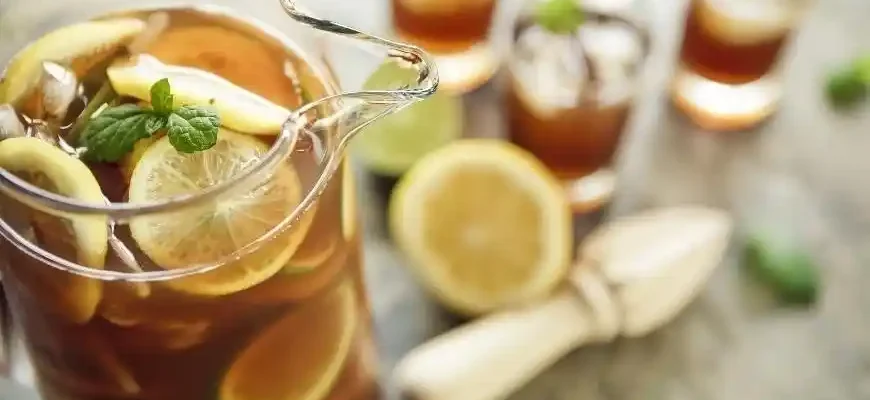Iced tea – the perfect refreshment for a hot summer day, an energizing drink for a sluggish afternoon, and an easy-to-make beverage that spans across cultures and generations. Whether you’re sipping it poolside, at a barbecue, or simply at home, iced tea is one of those drinks that never goes out of style. But while making iced tea sounds simple, there’s a bit more to it than just pouring hot tea over ice.
Let’s walk through everything you need to know about making iced tea, from the basics to the finer details, and from various perspectives to ensure you get the most out of your tea-making adventure. I’m not going to hide anything here—everything I’ve learned in my years of experience with this humble drink will be laid out clearly and honestly for you.
The Basics: What You Need to Know
1. Choosing the Right Tea
It all starts with the tea itself. Traditionally, iced tea is made with black tea, but don’t feel restricted—green tea, white tea, herbal blends, and even flavored teas (like hibiscus or chamomile) work well too. The key is to pick a tea you love, because the flavor will be at the heart of the whole drink.
- Black Tea: Rich and robust, black tea is the classic choice for iced tea. It holds up well to ice and retains its flavor.
- Green Tea: A lighter, more refreshing option. Just keep in mind it can become bitter if brewed too hot or for too long.
- Herbal Teas: Caffeine-free and often fruity or floral, herbal teas are great for those who want to avoid the buzz from caffeine.
- Flavored Teas: Think Earl Grey, jasmine, or chai—these offer an extra layer of complexity that can make your iced tea stand out.
2. Brewing the Tea

Here’s where many people get it wrong. For the best iced tea, you want to brew it strong enough to hold its flavor even after it’s chilled and diluted by the ice. Start with the basics:
- Water Temperature: For black and herbal teas, bring the water to a full boil (around 212°F/100°C). For green and white teas, use water that’s around 170°F-180°F (77°C-82°C) to prevent bitterness.
- Steeping Time: Black tea needs about 3-5 minutes of steeping. Green tea is more delicate—just 2-3 minutes. If you steep too long, the tea will be overly bitter.
The tea-to-water ratio is also key. A general guideline is 1 teaspoon of loose leaf tea (or 1 tea bag) per 8-ounce cup of water. If you’re making a larger batch, just scale it up accordingly.
Pro Tip: If you want a richer, smoother flavor, try cold brewing. This involves steeping the tea in cold water for several hours (usually 6-8 hours in the fridge). Cold-brewed tea has a gentler taste with less bitterness, perfect for a refreshing summer drink.
3. Sweetening (Optional)
Now comes the big question: do you want sweet iced tea? Sweet tea is a Southern tradition, but there’s no rule that says you have to go down that path. Some like it sweet, others like it unsweetened. Here’s a rundown on how to sweeten:
- Simple Syrup: The most popular method. To make simple syrup, combine equal parts sugar and water, heat until the sugar dissolves, and let it cool. You can add it to your iced tea to your desired sweetness.
- Honey or Agave: If you prefer natural sweeteners, both honey and agave syrup can offer a more complex flavor. Just be aware, they might not dissolve as easily in cold tea, so a little warmth can help.
- Stevia or Monk Fruit: For those avoiding sugar, these are great alternatives. But, use sparingly! These sweeteners are far sweeter than regular sugar, and a little goes a long way.

Pro Tip: Sweeten your tea while it’s still warm—cold tea doesn’t absorb sugar or syrup as well.
4. Cooling the Tea
Once you’ve brewed your tea, it’s time to cool it down. There are a few methods for this, but the goal is always the same: you want to chill the tea without watering it down too much.
- Ice Cubes: Pour your tea directly over ice, and it’ll cool rapidly. However, if you just dump in ice cubes, your tea may become diluted quickly.
- Ice Blocks: A smarter method is to freeze some of your tea in an ice cube tray and use those cubes to chill your tea. This way, your tea stays strong as it cools.
- Refrigerator: Let the tea come to room temperature, then pop it in the fridge for an hour or two to chill completely.
5. Serving Your Iced Tea
When your tea is ready and chilled, serve it in a tall glass filled with fresh ice. Add a slice of lemon, a sprig of mint, or even a splash of fruit juice for a fun twist. If you like a little extra flavor, try infusing your iced tea with herbs, citrus peels, or berries as it cools.
Variations: Making Iced Tea Your Own
1. Flavored Iced Tea

Don’t be afraid to get creative. Adding fruits like strawberries, peaches, or even a bit of ginger can elevate your iced tea. Simply add your fruit to the tea during the cooling phase, and let it infuse for a few hours before serving. You can also use pre-flavored teas or tea blends to add extra dimension.
2. Iced Tea Lemonade (Arnold Palmer)
One of the best combinations out there—half iced tea, half lemonade. This is the perfect balance between tart and sweet, and it’s great for a crowd. Just mix equal parts of your favorite iced tea and lemonade, and serve over ice.
3. Sparkling Iced Tea
Want to make your iced tea a little more festive? Add some sparkling water! This adds a delightful fizz to your tea, making it feel like a special occasion. Just mix your iced tea with sparkling water in a 2:1 ratio, and you’re good to go.
Potential Pitfalls: What to Avoid
No, iced tea isn’t complicated, but there are a few things that can go wrong:
- Oversteeping: This leads to bitterness. If you’re unsure, err on the side of understeeping, especially with green tea.
- Diluted Flavor: Don’t let the ice melt and drown the taste of your tea. Use larger ice cubes or tea ice cubes to prevent dilution.
- Too Much Sugar: It’s easy to overdo it with sweeteners. Remember, you can always add more, but you can’t take it out once it’s in. Go slow and taste as you go.
If you find that your iced tea isn’t tasting as good as you hoped, it might be time to experiment with different teas or sweeteners. Not all teas behave the same way, and some may not work as well for iced tea.

Real People, Real Opinions
Here are a few thoughts from different people about their iced tea habits:
- Maria, 55, Spain: “I’ve always been a fan of green tea iced. The trick is to brew it just right—not too long, and never too hot! I also like to add a touch of honey and fresh mint. It’s so refreshing.”
- Jason, 28, USA: “I’ve never been a big fan of the sugary, Southern-style sweet tea, so I like my iced tea unsweetened. I usually make it with black tea and throw in a lemon slice or two. Simple, but it works for me.”
- Anita, 65, India: “I love to make iced chai. It’s a bit unusual, but the spice mix—cardamom, cinnamon, and cloves—makes it so fragrant and enjoyable. I usually brew it strong and add some milk before cooling it down.”
- Hiroshi, 40, Japan: “I prefer my iced tea with a bit of jasmine flavor. I steep it cold overnight, so it’s smooth and delicate. The subtle fragrance is perfect for a hot summer afternoon.”
- Liam, 22, Canada: “I’m a huge fan of fruit-infused iced tea. Blueberries, raspberries, or even a splash of lime juice—these little additions make a big difference. I make a big jug of it and keep it in the fridge all week.”
Conclusion
Making iced tea is not only easy, it’s a perfect way to explore different flavors and create a drink that’s truly yours. Whether you stick with the classic, dive into fruity infusions, or experiment with something totally new, iced tea is a versatile and refreshing choice. So, next time you feel a little parched, skip the store-bought sugary drinks and try making your own iced tea at home. You’ll not only love the flavor but feel the pride of having created something delicious with your own hands.
And hey, if it doesn’t turn out perfect the first time, don’t stress—it’s all part of the learning experience. After all, even the best chefs had to burn a few batches before perfecting their craft, right?









